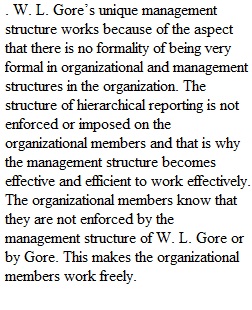


Q Discussion Board7: W. L. GORE SUCCEEDS WITH INFORMAL ORGANIZATIONAL STRUCTURE No unread replies.No replies. Please watch the following video, then read the case and post at least three paragraphs answering the three discussion questions below. Respond to at least two of your classmates following the 2+2 rule described in the Discussion Board Instructions in the Introduction Module. Terri Kelly: W.L. Gore's Original Management Model (Links to an external site.)Links to an external site. DB8 - W. L. GORE SUCCEEDS WITH INFORMAL ORGANIZATIONAL STRUCTURE W. L. Gore & Associates, the chemical and manufacturing company best known for Gore-Tex fabric, is a fascinating success story. It has over 10,000 employees at offices in over 50 countries, is ranked 22nd on Fortune’s 2014 “100 Best Companies to Work For” list, and—from its founding in 1958—has never posted an operating loss. During this time, it has held to a unique management structure: almost no formalized bosses, no structured hierarchy, and no set chains of command. In doing so, it has proven that a structure antithetical to a traditional hierarchical management structure can work well if done correctly. Gore uses what it calls a “team-based, flat lattice” organizational structure. The company is built around self-creating, multidisciplinary teams, which form in response to problems, opportunities, or shared skills and interests. Employees can choose their own projects but in return hold themselves, and each other, strictly accountable to deliver results. As CEO Terri Kelly puts it, “There are two sides to the coin: freedom to decide and a commitment to deliver on your promises.” Leaders emerge naturally from these teams and gain management power not by formalized titles or privileges but by the demonstrated willingness of others to follow them. Compensation is determined by a detailed peer review process meant to award employees who have contributed most to the company with the highest salaries. Gore does not pretend that it has overcome the need for company organization, strong leadership, employee accountability, and high performance needed for all organizations. Instead, it simply claims to have found alternative ways to achieve them, such as a strong focus on exemplifying company values and a powerful peer-review and accountability system. Whatever analysts might say about the company’s unusual approach, it has been successful. Discussion Questions 1. Why does W. L. Gore’s unique management structure work? 2. What trade-offs does W. L. Gore make by using the flat lattice structure? In other words, are there certain disadvantages that W. L. Gore has chosen to accept in return for other benefits? 3. Would you like to work in a flat lattice—style organization? Why or why not?
View Related Questions